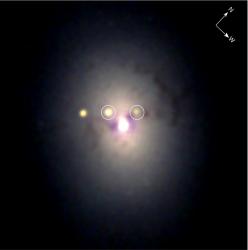The rate of supernovae in the galaxy NGC 1316 is greater than the galactic average of 3 per century - it experienced 4 supernovae in 26 years. The scientists are checking if this is because it is a fresh merger between two galaxies

A rare event was recently captured by NASA's Swift satellite instruments: two supernovae side by side in one galaxy. Large galaxies typically host three supernovae per hundred years. The galaxy NGC 1316 experienced two supernovae less than five months apart and a total of 4 supernovae in 26 years, far more than the previous record. This makes NGC 1316 one of the massive producers of supernovae.
A side-by-side image of the two supernovae was taken by Swift. The first supernova, still visible on the right side of the image was discovered on June 19, 2006, and was named SN 2006dd. The second one, on the left side of the image, was discovered on November 5 and was named SN 2006mr... Other objects in the image include a bright spot in the center of the galaxy - the galactic nucleus, and a bright object far to the left, like an earring, a star that is between us and the galaxy.
NGC 1316 is a massive elliptical galaxy about 80 million light-years away that recently merged with a spiral galaxy. The merger did cause supernovae by accelerating the creation of massive new stars, which quickly die and explode. However, all four supernovae in NGC 1316 appear to belong to type Ia, a type that was not previously thought to be related to the process of star formation in merging galaxies. The scientists are investigating whether the fast rate of supernovae is a coincidence or a result of the merger. The Swift satellite was launched about two years ago - on November 20, 2004, and it began to operate fully in January 2005, and since then it has observed more than 200 gamma ray bursts, and more than a thousand other astronomical objects.

4 תגובות
One of the astrophysical dilemmas in the study of the universe is presented in the question: how do galaxies merge, in view of the big bang theory, that the universe is expanding?
And equally important dilemmas: is it possible to estimate the location where the explosion occurred; Also, is there a tendency to place the center of the bang near the earth in light of a mistake in the historical past (before Copernicus, Bruno, and Galileo), when they believed then that the earth was at the center of the universe?
For the first, only you can't prove it and they can (tiny difference)
"Scientists investigate whether the fast rate of supernovae is a coincidence or a result of the merger"
Wow! So let me tell them that there is a strong connection to the merger without being an astronomer….